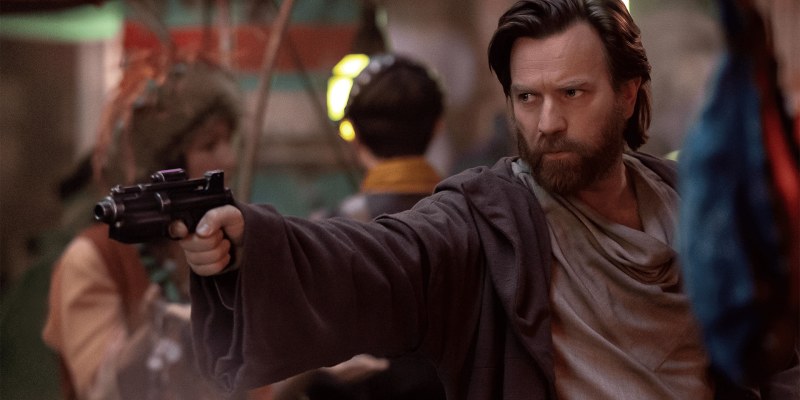This discussion and review contains spoilers for episode 1 (“Part I”) and episode 2 (“Part II”) of Obi-Wan Kenobi on Disney+.
Star Wars has had a Skywalker problem for a while now. Despite millennia of an entire galaxy at their disposal, stories have seemed unable to escape the gravity of the Skywalker bloodline. We saw it with Disney’s sequel trilogy, especially its complete stumble of a final installment in The Rise of Skywalker. And we saw it with The Mandalorian, where the season 2 finale reveal of Luke delighted on a surface level, but once again made the story about this small group of people at this specific moment in time.
Going into the six-part miniseries event Obi-Wan Kenobi on Disney+, which has Ewan McGregor reprising his titular role 17 years after Revenge of the Sith, it looked as though we were about to fall into the same trap once again. Trailers revealed the over-trodden sands of Tatooine, brief shots of a 10-year-old Luke Skywalker, and the promised return of Hayden Christensen as Darth Vader, all of which cemented a return to a very familiar time and place in a galaxy far, far away.
After watching the first two episodes of Obi-Wan Kenobi, “Part I” and “Part II,” it certainly feels like an intimate reunion with a character and actor that most consider to be one of the bright spots of the prequel trilogy. However, the two installments contain enough craft, grounded performances, and surprising reveals to help it rise above the Skywalker stumbles of the Disney era. Thanks in part to confident direction by Deborah Chow and a powerful score by Natalie Holt, the opening of Obi-Wan Kenobi is in the same league as The Last Jedi, Rogue One, and the finale of The Clone Wars as some of the best Star Wars we’ve gotten in quite some time.

Right off the bat, I’m thrilled at how the series was marketed — more specifically, the things that were held back in said marketing. It feels like nearly every shot we saw in the trailers came from these first two episodes, meaning that we have four hours left of complete surprises. The show managed to use Tatooine, a planet that I’m sure all of us are sick of by now, in a smart way by economically showing us the prison-like monotony that Obi-Wan has lived in for the past decade since his exile. Seeing the former Clone Wars general and Jedi Master with his head down as a meat packer carving Krayt dragon sashimi and only being paid half of what he deserved epitomizes this. After living a life filled with honor, servitude, and altruism, he is now forced to remain actionless in the face of injustice, all so that he can keep a low profile as he watches over a young Luke Skywalker from afar.
Small details during this first episode on Tatooine helped it stand out from the other countless times we’ve visited the Outer Rim planet. Owen Lars throwing the familiar T-16 skyhopper toy back at Obi-Wan, and chastising him for wanting Luke to suffer the same fate as his father, is a brutal and effective moment. As is Kenobi’s refusal to help out Nari, another Jedi in hiding played by Benny Safdie. As Nari begs, “What happened to you? You were once a great Jedi,” Obi-Wan quickly responds with the blunt truth, “The time of the Jedi is over.”
The nightmares of the past still haunt Obi-Wan, and he calls out in vain to Qui-Gon Jinn to offer him some kind of guidance. While those calls have seemingly gone unanswered over the past decade, I fully expect this to be Chekov’s Force Ghost and to see Liam Neeson reprise his role at some point in the coming weeks.

But perhaps the best sleight of hand played by the marketing was hiding why Obi-Wan would leave his secret post on Tatooine in favor of the grimy cacophony of Daiyu. Not long into “Part I,” it becomes clear that the reason isn’t the Skywalker twin he’s keeping watch over, but the one on the other side of the galaxy. Seeing a young Leia running through the forests of Alderaan, telling off her bratty cousin at a fancy soiree, and exuding that classic Skywalker sense of curiosity all does a great job of showing us that she was a rebel long before she led the Rebellion.
Hinging these Obi-Wan Kenobi episodes on a 10-year-old Leia could’ve gone so, so wrong. But showing us Leia during this time period adds layers to her story that, alongside her appearances in the excellent Rebels, help flesh out one of the most iconic characters in the saga. And while Star Wars hasn’t always had the best luck with child performances, kudos to Vivien Lyra Blair for stepping into those immense shoes. While she’s best known for her role in 2018’s Bird Box, she nails the role of a kid who, some eight years from now, will send a critical message: “Help me, Obi-Wan Kenobi. You’re my only hope.”
Obi-Wan and Leia’s stories quickly collide once Leia is kidnapped by the bounty hunter Vect Nokru, played by Flea from the Red Hot Chili Peppers in one of the series’s many strange-but-effective casting choices. This comes at the order of Reva, the Third Sister Inquisitor. While details about her are still murky, I get the sense that she’s one of the surviving Jedi Padawan students in the opening scene during Order 66. That powerful moment adds yet another piece to the Order 66 tableau, alongside the ending of The Clone Wars, the opening of The Bad Batch, and Jedi: Fallen Order.

Played excellently by Moses Ingram, the Third Sister’s anger, frustration, and impatience all contribute to her mystery. She harbors a very specific hate for Obi-Wan Kenobi in “Part I” and “Part II,” and this obsession with finding him comes from her getting what he’s “owed.” Despite ranking lower than the Fifth Brother and Grand Inquisitor himself, she proves she is not easily disciplined by them. Given her role in the incredible scene where she reveals to Obi-Wan that Darth Vader / Anaking Skywalker is still alive, perhaps there’s some connection there. Although, as a side note, it’s a bit strange that we’re led to believe that she kills the Grand Inquisitor, considering he plays a prominent role in Rebels, which takes place four years or so after this series.
I love that “Part II” immediately leaves Tatooine in the rear-view mirror, taking us to the crowded streets of Daiyu. Once again, small details, strong casting, and a quick pace all help keep Obi-Wan Kenobi from repeating the stumbles of other recent Star Wars stories. Seeing Temuera Morrison as a destitute veteran clone trooper begging for money, juxtaposed by the sight of stormtroopers walking by and completely ignoring him, adds a great texture to this period of the story. Likewise, Kumail Nanjiani is wonderful as Haja Estree, a con artist who uses magnets and hidden switches to convince people that he’s a Jedi.
Any fears that we’d be spinning our wheels for several episodes waiting for Obi-Wan to find Leia were quickly allayed, and the two of them share several great scenes together. I dug the excitement of the Breaking Bad-esque meth lab rescue and subsequent rooftop chase. I loved Obi-Wan’s use of the Force for the first time in possibly a decade to save a falling Leia, a moment that echoes Kal in the opening of Jedi: Fallen Order. And of course, Leia’s brash independence and bravery reminding Obi-Wan of her mother Padme yields real poignancy.
So much of Obi-Wan Kenobi “Part I” and “Part II” works because of McGregor’s weathered performance — the grays in his beard, wrinkles on his forehead, and life drained from his eyes. Whether it’s by Owen or Reva or just the state of the galaxy itself, he’s continually reminded of how he failed Anakin. He’s a man who’s lost hope, and it feels like this series is built around the events that finally cause him to regain it. The first third of Obi-Wan Kenobi sets an incredible table — hopefully the rest of the series can nail the meal itself.
